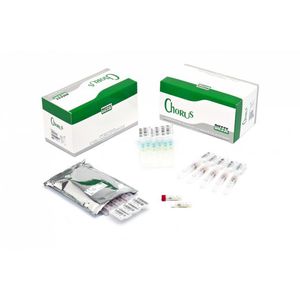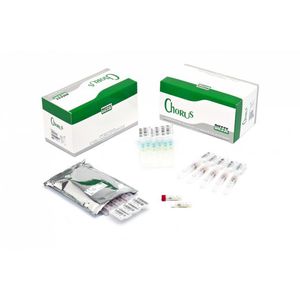
- Laboratory
- Laboratory medicine
- Infectious disease test kit
- Diesse Diagnostica Senese
Parvovirus assay kit 81150serumELISA
Add to favorites
Compare this product
Characteristics
- Micro-organism
- parvovirus
- Sample type
- serum
- Analysis mode
- ELISA
- Result display time
40 min
- Specificity
99.7 %
- Sensitivity
99.3 %
Description
Parvovirus B19 is the smallest known virus; it was discovered in the blood of donors in 1974 and up to now three different genotypes were identified. It has a high stability against environmental factors and detergents.
Parvovirus B19 infections are present in all the world, especially during spring; epidemic attacks can occur in kindergartens and schools. The virus is transmitted by aerosol, through the blood or its derivatives or through the placenta; the incubation period is between 4 and 14 days and it can be detected in infected patients’ serum between the third and the sixteenth day after infection.
In healthy adults the detection of antibodies gives positive results in about 70% of cases. Acute infections are more frequent between 6 and 15 years old. In children, the virus causes the fifth disease.
When the rash appears, the patient is no longer infectious. In some cases arthritic manifestations with arthralgia can appear.
The virus replicates in the erythroblasts causing temporary anemia; the infection can lead to complications in immunocompromised patients. Infection during pregnancy can cause inhibition of erythropoiesis in the fetus resulting in anemia and fetal hydrops even until death.
The determination of anti-Parvovirus B19 antibodies by ELISA technique is the standard method for the diagnosis of Parvovirus infections: IgM are detected up to 3-5 months from infection while IgG appear by the third week of infection and persist for the life.
Method
Immunoenzymatic method for the qualitative determination of IgG and IgM-class antibodies to Parvovirus B19 in human serum, using a disposable device applied on the Chorus and Chorus TRIO instruments.
Catalogs
No catalogs are available for this product.
See all of Diesse Diagnostica Senese‘s catalogsRelated Searches
- Assay kit
- Blood assay kit
- Serum assay kit
- Immunoassay assay kit
- Plasma assay kit
- Infectious disease detection kit
- Blood rapid diagnostic test
- Rapid lateral flow test
- Immunoassay rapid diagnostic test
- Cassette rapid diagnostic test
- Rapid virus test
- Respiratory infection test kit
- Clinical assay kit
- Whole blood rapid diagnostic test
- Rapid respiratory infection test
- ELISA assay kit
- IgG test kit
- COVID-19 rapid diagnostic test
- Feces test kit
- Influenza A assay kit
*Prices are pre-tax. They exclude delivery charges and customs duties and do not include additional charges for installation or activation options. Prices are indicative only and may vary by country, with changes to the cost of raw materials and exchange rates.


















